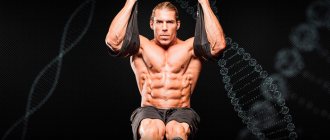Probably, now only the lazy do not talk about the abdominal muscles. Indeed, a thin waist and strong abdominal muscles are attractive and beautiful for both men and women. But the role of the abdominal press is associated not only with beauty, but also with health. These muscles form the abdominal wall. Imagine if they weren’t there - the internal organs would stretch the skin of the abdomen to incredible sizes.
There are only three of these muscles on each side, and the most attractive are the rectus abdominis muscles. They are tied with tendon bridges, and it is these six packs of muscle fibers that are a symbol of perfection for most men who care about their appearance. The rectus abdominis muscles begin from the ribs and attach to the pelvic bones. Their task is to bend the lumbar spine.
Abdominal muscles
On the sides of the rectus muscles are the external, and below them are the internal oblique muscles of the abdomen. Since the direction of their fibers is oblique, they can also perform rotations of the body. Well, the deepest one is the transverse abdominis muscle, which can only be seen by a surgeon during abdominal surgery.
Let's feel the work of the abdominal muscles. To do this, it is better to sit on a chair. Now bend forward slightly at the waist while contracting your abdominal muscles.
Now, keeping your abdominal tension, slowly straighten your torso and lower back. Just at this moment you will fully feel the full power of these muscles.
Together with the long and deep muscles of the back, the abdominal muscles work as stabilizers of the lower back. That is, they, simply put, keep the lower back in the desired position. But if you read carefully, you noticed that the muscles of the anterior and lateral abdominal wall are not attached to the spine at all. How do they manage to hold the vertebrae?
The fact is that they participate in the work of the lower lumbar lever, which, as you remember, is connected to the pelvic bones and lower lumbar vertebrae. Its work is easy to understand using the example of children's swings. If you firmly grasp one end of the swing, the other will also be motionless. This is exactly how the abdominals work.
Physiological, correct posture reduces the perception of pain. A person with a straight back recovers faster and easier from pain syndrome, which does not become chronic.
When it is tense, the pelvic bones are fixed, that is, one end of the lever is strengthened, naturally, the other end in the form of vertebrae also maintains the given position. Another consequence of abdominal muscle tension is the parallel alignment of the vertebral bodies relative to each other. This means that the pressure inside the intervertebral disc is distributed evenly and does not push the disc core out - there is immediate prevention of the formation of a disc herniation.
Not everyone has the habit of keeping their abdominal muscles in good shape. Typically, the abdominal muscles are especially weakened in people with flat-concave and round-concave posture. That is, for those whose lumbar curve is too pronounced. Moreover, such posture is not the cause, but a consequence of weakness of the abdominal muscles. A weak press simply cannot give the pelvic bones a more horizontal position, the angle of the pelvis increases, and the lumbar curve turns into a rather deep hole.
Always keep your abdominals contracted when placing stress on your lumbar spine. For example, when moving from an apartment to a country house. How many times do you have to bend forward for both a small box and a heavy bag. If the abdominal muscles are relaxed at these moments, then just when you unbend and lift the load, all efforts through the lower lever are transmitted to the lumbar intervertebral discs. And for some they can’t stand it – a crack appears and then a hernia, as well as other troubles.
It is important to keep the abdominal muscles tense during significant physical activity on the lumbar spine. A weightlifting training belt is believed to protect the lower back when lifting heavy weights during training. However, if you do not strain your abdominal muscles while lifting weights, such a belt will have little benefit. Even with a tightly tightened belt, it is necessary to consciously contract the abdominal muscles, then you can lift a heavier weight and save your lower back.
The most harmful exercise for the spine
There are many exercises to strengthen your abdominal muscles. Among them there are both useful and dangerous, harmful primarily to the spine itself. For example, the most harmful exercise when training the abdominal muscles is lifting the torso from a lying position with fixed feet.
Below I will give seven exercises for the press. You can take all of these exercises and make them into a separate ab workout, or you can incorporate some of them into your regular workout routine.
What causes lower back pain?
Low back pain is the fifth most common reason why people visit a doctor. More than 85 percent of patients have nonspecific low back pain, or pain that is not caused by a disease or spinal pathology.
Nonspecific back pain can be caused by the following reasons:
- muscle spasm
- muscle tension
- nerve damage
- degenerative changes
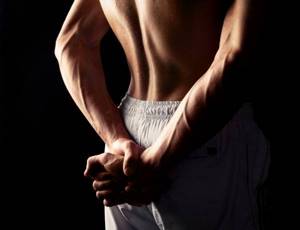
Some specific and more serious causes of back pain include:
- compression fractures
- spinal stenosis
- disc herniation
- cancer
- infection
- spondylolisthesis
- neurological disorders
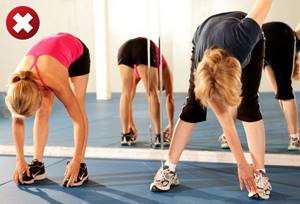
Touching your toes
Not all exercises are beneficial. Any slight discomfort felt at the beginning of these exercises should disappear as the muscles become stronger. But if the pain lasts more than 15 minutes during exercise, patients should stop and consult a doctor. Some exercises can make the pain worse. Touching your toes while standing, for example, puts more stress on the discs and ligaments of the spine. They can also strain the muscles in your lower back and hips.
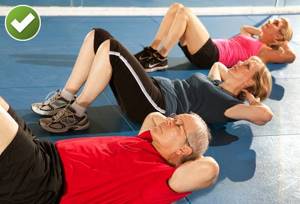
Neck rotation
Many of you may remember this exercise from school physical education lessons. During warm-up, almost all teachers forced students to do this. They should not be blamed for this, because they also did these harmful exercises at one time, unaware of the dangers of these exercises. When a person rotates his head, and especially if he does it with great enthusiasm, it has a detrimental effect on the cervical spine .
Instead of this exercise, when warming up your neck, it is best to swing both arms (straight) forward or backward. When swinging your arms, not only the cervical region, but also the chest region warms up. You can also tilt your head back and forth and left and right.
For those who really like to warm up their neck by rotating their head, there are a couple of tips, using which they will not harm the spine: do not do this exercise at a fast pace; during rotation, do not throw your head back, i.e. rotation should not be done in a circle, but, as it were, in a “semicircle”.
Partial crunches
Certain exercises can aggravate back pain and should be avoided if you have severe lower back pain. Partial crunches can help strengthen your back and abdominal muscles. Lie down with your knees bent and your feet on the floor. Cross your arms over your chest or place your hands behind your neck. Tighten your abdominal muscles and lift your shoulders off the floor. Exhale as you lift your shoulders. Don't move your elbows or use your arms to lift your neck off the floor. Hold for a second, then slowly lower down. Repeat 8 to 12 times. Proper form prevents undue stress on the lower back. Your legs, tailbone, and lower back should remain in contact with the mat at all times.
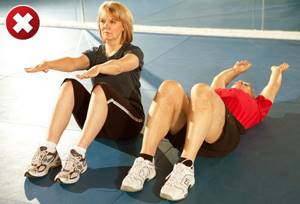
Leg raises while lying on your back
Leg raises are sometimes suggested as an abdominal exercise. If you have weak muscles, this exercise may make your back pain worse. Instead, try lying on your back in an extension position with one leg straight and the other leg bent at the knee. Support your lower back on the floor. Slowly lift your straight legs up and hold briefly. Repeat 10 times, then switch legs.
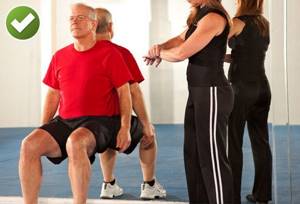
What exercises are bad for your back?
How to avoid pulling muscles during physical education, hurting your back, and harming your health.
Before summer, many of us want to get our figures in order, and therefore begin to show remarkable physical activity in order to have time to prepare for the beach season.
And in general, these initiatives are very commendable.
However, after some time, we suddenly begin to notice that for some reason our health has worsened: our back begins to hurt, we suffer from headaches, and stretched muscles make themselves felt.
How can you avoid harming yourself with such unhealthy exercises and do the exercises correctly?
Neurologists advise.
Attention: the photos below show exercises with errors!
Top 5 mistakes when doing morning exercises:
1. Squats: Don't squat too low and round your back.
Squats are very useful for strengthening the muscles of the legs and buttocks. But it must be done correctly.
Common mistakes:
- low squat (sharper than 90 degrees) – blood circulation in the legs is disrupted and the meniscus in the knee joint is “pinched”
- a round back or bending forward causes pinching in the lumbar region.
How to correctly:
- To begin, squat while holding onto handrails (such as door handles). This will relieve excess tension in the hip joints,
- keep your back straight, or tilt it back slightly.
2. Walking on the buttocks: do not turn your torso, do not round your back
“Walking” on the buttocks is also very beneficial for the gluteal and hip muscles, provided that it is performed without errors.
A few more tips for beginning athletes:
- Try to do exercises for at least 15 minutes, 7-10 repetitions each exercise
- Repeat your exercises 2 times a day (morning and evening). So you will get half an hour of physical activity a day, and the results will not keep you waiting
- Even with a small amount of exercise, start your workout with a warm-up that includes gentle exercises. For example, gradual muscle stretching, slow bending and bending.
- If possible, engage in physical activity under the guidance of a qualified trainer. To do this, you can attend a 10-day course of statutory gymnastics at the Kazan Kinesitherapy Center.
:
Source: https://ckt-kzn.ru/kakie-uprazhneniya-vrednyi-dlya-spinyi/
Raising legs face down
Get down on your hands and knees and tighten your abdominal muscles. Raise one leg behind you. Keep at hip level. Hold for 5 seconds and then switch to the other leg. Repeat 8 to 12 times for each leg, and try to lengthen the time you hold each lift. As you lift, try lifting and extending your opposite arm for each rep. This exercise is a great way to learn how to stabilize your lower back while moving your arms and legs. While performing this exercise, do not allow your lower back muscles to sag.
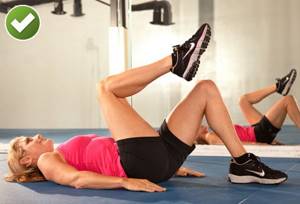
Bridge
Lie on your back with your knees bent and just your heels on the floor. Press your heels into the floor, squeezing your glutes and lift your hips from the floor to your shoulders, keeping your hips and knees in a straight line. Hold for about 6 seconds and then slowly lower your hips to the floor and rest for 10 seconds. Repeat 8-12 times. Avoid arching your lower back as your hips move upward.
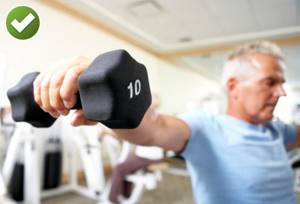
Lifting free weights
If done correctly, lifting weights won't harm your back and can help relieve chronic pain. But when you have severe back pain, the added stress on your back muscles and ligaments can increase your risk of further damage. Ask your doctor whether you should lift weights and what exercises to avoid.

Aerobic exercise
Aerobic exercise strengthens your lungs, heart and blood vessels and can help you lose weight. Walking, swimming, cycling can help reduce back pain. Start with short sessions. If your back hurts, try swimming, water supports your body. Avoid any exercises that twist your body.

Posture and abdominal muscles. The most harmful exercise for the spine
Probably, now only the lazy do not talk about the abdominal muscles. Indeed, a thin waist and strong abdominal muscles are attractive and beautiful for both men and women. But the role of the abdominal press is associated not only with beauty, but also with health. These muscles form the abdominal wall. Imagine if they weren’t there - the internal organs would stretch the skin of the abdomen to incredible sizes.
There are only three of these muscles on each side, and the most attractive are the rectus abdominis muscles.
They are tied with tendon bridges, and it is these six packs of muscle fibers that are a symbol of perfection for most men who care about their appearance.
The rectus abdominis muscles begin from the ribs and attach to the pelvic bones. Their task is to bend the lumbar spine.
Abdominal muscles
On the sides of the rectus muscles are the external, and below them are the internal oblique muscles of the abdomen. Since the direction of their fibers is oblique, they can also perform rotations of the body. Well, the deepest one is the transverse abdominis muscle, which can only be seen by a surgeon during abdominal surgery.
Let's feel the work of the abdominal muscles. To do this, it is better to sit on a chair. Now bend forward slightly at the waist while contracting your abdominal muscles. Now, keeping your abdominal tension, slowly straighten your torso and lower back. Just at this moment you will fully feel the full power of these muscles.
Together with the long and deep muscles of the back, the abdominal muscles work as stabilizers of the lower back. That is, they, simply put, keep the lower back in the desired position. But if you read carefully, you noticed that the muscles of the anterior and lateral abdominal wall are not attached to the spine at all. How do they manage to hold the vertebrae?
The fact is that they participate in the work of the lower lumbar lever, which, as you remember, is connected to the pelvic bones and lower lumbar vertebrae. Its work is easy to understand using the example of children's swings. If you firmly grasp one end of the swing, the other will also be motionless. This is exactly how the abdominals work.
Physiological, correct posture reduces the perception of pain. A person with a straight back recovers faster and easier from pain syndrome, which does not become chronic.
When it is tense, the pelvic bones are fixed, that is, one end of the lever is strengthened, naturally, the other end in the form of vertebrae also maintains the given position.
Another consequence of abdominal muscle tension is the parallel alignment of the vertebral bodies relative to each other.
This means that the pressure inside the intervertebral disc is distributed evenly and does not push the disc core out - there is immediate prevention of the formation of a disc herniation.
Not everyone has the habit of keeping their abdominal muscles in good shape. Typically, the abdominal muscles are especially weakened in people with flat-concave and round-concave posture. That is, for those whose lumbar curve is too pronounced.
Moreover, such posture is not the cause, but a consequence of weakness of the abdominal muscles.
A weak press simply cannot give the pelvic bones a more horizontal position, the angle of the pelvis increases, and the lumbar curve turns into a rather deep hole.
Always keep your abdominals contracted when placing stress on your lumbar spine. For example, when moving from an apartment to a country house. How many times do you have to bend forward for both a small box and a heavy bag.
If the abdominal muscles are relaxed at these moments, then just when you unbend and lift the load, all efforts through the lower lever are transmitted to the lumbar intervertebral discs.
And for some they can’t stand it – a crack appears and then a hernia, as well as other troubles.
It is important to keep the abdominal muscles tense during significant physical activity on the lumbar spine. A weightlifting training belt is believed to protect the lower back when lifting heavy weights during training.
However, if you do not strain your abdominal muscles while lifting weights, such a belt will have little benefit.
Even with a tightly tightened belt, it is necessary to consciously contract the abdominal muscles, then you can lift a heavier weight and save your lower back.
The most harmful exercise for the spine
There are many exercises to strengthen your abdominal muscles. Among them there are both useful and dangerous, harmful primarily to the spine itself. For example, the most harmful exercise when training the abdominal muscles is lifting the torso from a lying position with fixed feet.
Below I will give seven exercises for the press. You can take all of these exercises and make them into a separate ab workout, or you can incorporate some of them into your regular workout routine.
Exercise 1 - oblique crunches
There are many variations of crunches. To perform this exercise, lie on your back, bend your knees, and place your feet on the floor. Place the ankle of your left foot over your right knee and place your hands behind your head. While pressing your lower back toward the floor, lift your shoulder blades off the floor and then twist your upper body diagonally toward your left knee.
The key to working your abs and obliques with this exercise is to apply maximum tension at the top of the movement. Be sure to alternate legs so that both sides of your body develop harmoniously.
Exercise 2 - bicycle
You should definitely love this exercise because it works all the abdominal muscles without exception. When you add cycling exercise to your regular workout routine, you are sure to see results. This is a grueling exercise, but you have to endure it because a beautiful belly is worth it.
To perform the exercise, lie on the floor, bend your legs at an angle of 90 degrees, put your hands behind your head. Raising your shoulders off the floor, reach your right knee toward your left elbow and straighten your left leg. Continue alternating opposite knees and elbows.
Cycling is a great exercise that works all the abdominal muscles.
Try to raise your shoulders higher from the floor, despite the fact that it is more difficult to perform the exercise this way. This is necessary to put more stress on the abdominal muscles. Do more reps until your abs start to burn!
Exercise 3 – letter “V”
This is a complex and amplitude exercise. It is no coincidence that it is third on the list, because it is advisable to perform it after your abdominal muscles have received a good warm-up.
This exercise will push your abdominal muscles to the limit and may even result in muscle pain the next day.
In order to avoid back injury, you need to monitor the technique of performing the exercise and do it on a soft mat.
To begin, lie on your back and extend your arms above your head as if you were diving into a pool. Now use your abdominal muscles to lift your upper and lower body so that your body forms a “V” shape.
This is one of the more difficult abdominal exercises, but it's worth it.
You don't have to touch your toes with your hands on every rep if you can't do it without bending your arms. Gently lower your legs and body to the floor and relax. Do everything slowly and with concentration. Fast and sudden movements will only harm your abs and back.
Exercise 4 – reverse crunches
This exercise puts more stress on the lower abdominal muscles. It is quite simple, but fitness club visitors often forget about it.
Lie on your back and pull your knees up so that they are bent at a 90-degree angle. Now, using your abdominal muscles, lift your hips off the floor and pull your knees towards your shoulders.
By performing an exercise such as reverse crunches, you give a good workout to the lower abdominal muscles.
Don't make the mistake of putting all your weight on your neck. You don't need to move your hips too far. You will already feel the lower abdominal muscles working.
Exercise 5 – leg raises
This is another great exercise for the lower abdominal muscles. When you do it, your abs will simply burn! Be patient, to see the result you need to work until there is a slight burning sensation.
To perform the exercise, lie on the floor, stretch your legs and place your hands next to your buttocks, palms down.
This exercise is performed slowly. Try not to lift your lower back off the floor.
Slowly lift both legs off the floor until they are perpendicular to the floor. Hold this position for a second, and then slowly lower your legs until there are a few centimeters left of the floor. Hold your legs in this position for a couple of seconds and then lift them up again. Do not lift your lower back off the floor. If you want to make the exercise more difficult, place your hands behind your head.
Exercise 6 – Scissors in the horizontal plane
Scissoring is a fun exercise, but also quite challenging. When you do them, be sure to press your lower back into the floor.
Do not raise your legs high; there should be about 10 centimeters left to the floor.
Lie on your back and place your hands under your buttocks, palms on the floor. Raise your straight legs a few centimeters off the floor. Now move your legs in a criss-cross pattern for as long as you can. You can even record your time and try to beat it every next time.
Exercise 7 – Leg Swings
This exercise will be a great end to your workout. Leg swings are best done when the abdominal muscles are already tired and now need to be, as they say, polished.
Lie on your back and place your hands under your buttocks, palms down. Raise one leg 45 centimeters from the floor. Alternate your legs as if you were walking or swimming quickly—one up, one down.
Legs should be kept straight and heels should not be placed on the floor.
Do the exercise as intensely as you can, as if your life depended on it! When you can't take another swing, congratulations, you're ready to go home.
This exercise is a good way to complete your abdominal workout.
The above exercises are an excellent training program. Do them three times a week and within a month you will be surprised when you look at yourself in the mirror. And after three to four months of regular training, less successful fitness enthusiasts will begin to envy you.
Don’t forget about technique, try not to unnecessarily strain your lower back and neck muscles. If after a workout you feel like you're hurting where you shouldn't be, you might be doing something wrong. Focus on your sensations and learn to feel your own body, as well as enjoy the training process itself.
Source
Source
Source: https://polonsil.ru/blog/43426685248/Osanka-i-myishtsyi-zhivota.-Samoe-vrednoe-uprazhnenie-dlya-pozvo








